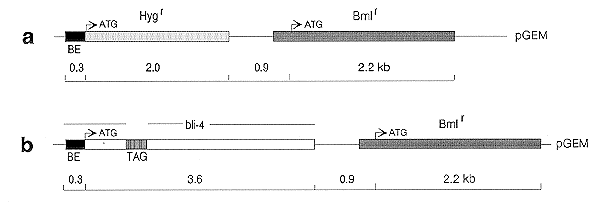
Figure 1.
A. Construct: blue-light box of bli-4 Hygr gene - Bmlr gene in a pGEM vector B. Construct: blue-light box of bli-4-tagged bli-4 - Bmlr gene, in a pGEM vector
Many genes of Neurospora crassa are regulated by blue light: al-1 (Schmidhauser et al. 1990 Mol. Cell. Biol. 10:5064-5070), al-2 (Lauter, Schmidhauser, Yanofsky, Russo unpublished), al-3 (Nelson et al. 1989 Mol. Cell. Biol. 9:1271-1276), bli-3, bli-4, bli-7, bli-13 (Sommer et al. 1989 NAR 17:5713-5723). For none of these genes are the blue light cis-regulatory sequences (blue-light elements, BE) known. Here we report the presence of such BE in front of bli-4. The blue-light element of bli-4 is in a stretch of DNA which is 300 bp long. We cloned this BE in front of a hygromycin reporter gene (Hygr) (Staben et al. Fungal Genetics Newsletter 36:79-81). Downstream of the reporter gene we cloned the selectable marker tub-2 (also called Bmlr), which gives resistance to benomyl (Orbach et al. 1986 Molec. Cell. Biol. 6:2452-2461). The distance between the BE and the translation start (ATG) of Bmlr is about 3,000 bp (Fig. 1A).
After transformation in N. crassa wt (St. Lawrence a) we selected several benomyl resistant transformants (H1 to H4). These transformants were grown in Vogel's liquid medium with the addition of 0.5 ug/ml benomyl and total RNA of dark grown and illuminated mycelia were extracted (T. Sommer et al. 1989 NAR 17:5713-5723). The Northern blots show that both the hygromycin gene (Fig. 2b) and the Bmlr gene were strongly light regulated.
Experiments with a similar construct, where a tagged bli-4 gene served as expression vector (Fig. 1b) gave different results. In the three B1-B3 transformants the tagged bli-4 gene was strongly light regulated (Fig. 2e) while the Bmlr gene was only weakly regulated (Fig. 2f). The simplest interpretation of this result is that the blue light element of bli-4 acts as an enhancer that functions well at a distance of 3,000 bp but not as well at a distance of 4,500 bp from the translation start of the Bmlr gene. A more complete understanding of blue-light regulation of gene expression in N. crassa will come from cloning and comparison of the properties of the blue-light element of several genes (see also Pandit and Russo 1991 Fungal Genetics Newsletter this issue).
Acknowledgements: We thank Chuck Staben and Charles Yanofsky (Stanford University) for providing the hygromycin reporter gene. We thank Uta Marchfelder for typing. This work was partially supported by the Deutsche Forschungsgemeinschaft.

Figure 1.
A. Construct: blue-light box of bli-4 Hygr gene - Bmlr gene in a pGEM vector
B. Construct: blue-light box of bli-4-tagged bli-4 - Bmlr gene,
in a pGEM vector
BE: Blue-light element of bli-4 gene
Hygr: hygromycin resistant gene (hph)
Bmlr: benomyl resistant gene (tub-2)
ATG: translation start
TAG: stretch of DNA not present in N. crassa
pGEM: plasmid of Promega
kb: kilobase

Figure 2. Northern Blot Analysis
a), d) Photos of the membranes used in b), c) and e),f) respectively just after blotting and before hybridization.
b) Hybridization of the membrane shown in a) with radiolabelled hygr gene.
c) Reprobing of the membrane a), after stripping, with radiolabelled Bmlr gene.
e) Hybridization of the membrane shown in d) with radiolabelled TAG DNA.
f) Reprobing of the membrane d), after stripping, with radiolabelled Bmlr gene.
wt: wild type (St. Lawrence, mt a)
H1-H4: four different transformants of wt with the construct a) of Fig. 1.
B1-B3: three different transformants of wt with the construct b) of Fig. 1.
C1-C2: transformants of wt with the hygromycin gene which has the Aspergillus trpC promoter(non-light regulated)